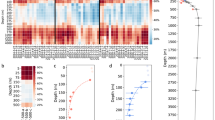Abstract
THE influx of bomb radiocarbon (14C) into the oceanic food chain has been evaluated by radiocarbon dating of pelagic organisms in the North Pacific1,2. These studies found a significant gradient with depth of Δ14C (the per mil deviation from the Standard' activity of nineteenth century wood). Such a gradient is not expected according to long-standing assumptions about carbon cycling in the water column3–5; instead, one could expect the Δ14C of organisms throughout the water column to have become equal to that in surface-water dissolved inorganic carbon (DIG) by about 1970 (10–20 years after the production of bomb radiocarbon). Here we present Δ14C values measured in the profiles of suspended and sinking particulate organic carbon (POC) from an open-ocean site and a coastal basin. The 14C activity of suspended POC decreases significantly with depth, as is observed in organisms, whereas that of sinking POC is only slightly lower than that in surface DIC and surface suspended POC. All POC Δ14C results, however, are greater than the corresponding pre-bomb, surface-derived DIC values, and therefore contain bomb 14C. This decrease in 14C activity requires a deep source (or sources) of carbon to sub-surface POC pools. Adsorptive processes involving low-14C-activity dissolved organic carbon (DOC) may provide a mechanism for lowering Δ14C values in suspended and (to a lesser extent) sinking POC.
Similar content being viewed by others
References
Pearcy, W. G. & Stuiver, M. Deep Sea Res. 30, 427–440 (1983).
Williams, P. M., Druffel, E. R. M. & Smith, K. L. Deep Sea Res. 34, 253–266 (1987).
Honjo, S. in Global Ocean Flux Study: Proceedings of a Workshop (ed. Honjo, S.) (National Academy Press, Washington DC, 1984).
Alldredge, A. L. & Silver, M. W. Prog. Oceanogr. 20, 41–82 (1988).
Bacon, M. & Anderson, R. F. J. geophys. Res. 87, 2045–2056 (1982).
Williams, P. M., Carlucci, A. F. & Olson, R. Oceanology Acta 3, 471–476 (1980).
Bruland, K. W., Franks, R. P., Landing, W. M. & Soutar, A. Earth planet Sci. Lett. 53, 400–408 (1981).
Sofer, Z. Analyt Chem. 52, 1389–1391 (1980).
Williams, P. M. & Druffel, E. R. M. Nature 330, 246–248 (1987).
Linick, T. W. Radiocarbon 22, 599–606 (1980).
Griffin, S. & Druffel, E. R. M. Radiocarbon 27(1), 43–51 (1985).
Jull, A. J. T., Donahue, D. J., Hathaway, A. L., Linick, T. W. & Toolin, L. J. Radiocarbon 28, 191–197 (1986).
Linick, T. W., Jull, A. J. T., Toolin, L. J. & Donahue, D. J. Radiocarbon 28, 522–533 (1980).
Stuiver, M. & Polach, H. A. Radiocarbon 19(3), 355–363 (1977).
Jackson, G. A. et al. Eos 70, 146–155 (1989).
Huh, C. A. et al. Cont. Shelf Res. 10, 137–164 (1990).
Druffel, E. R. M. J. mar. Res. 45, 667–698 (1987).
Berger, R., Taylor, R. E. & Libby, W. F. Science 153, 864–866 (1966).
Paerl, H. W. Science, 180, 496–498 (1973).
Karl, D. M., Knauer, G. A. & Martin, J. M. Nature 309, 54–56 (1984).
Bien, G. S., Rakestraw, N. W. & Suess, H. E. Limnol. Oceanogr. 10, R25–R36 (1965).
Emery, K. O. The Sea Off Southern California (Wiley, New York, 1960).
Eganhouse, R. P. & Kaplan, I. R. Mar. Chem. 24, 163–191 (1988).
Sugimura, Y. & Suzuki, Y. Mar. Chem. 24, 105–131 (1988).
Williams, P. M. & Druffel, E. R. M. Oceanogr. Mag. 1, 14–17 (1988).
Druffel, E. R. M., Williams, P. M. & Suzuki, Y. Geophys. Res. Lett. 16, 991–994 (1989).
Author information
Authors and Affiliations
Rights and permissions
About this article
Cite this article
Druffel, E., Williams, P. Identification of a deep marine source of particulate organic carbon using bomb 14C. Nature 347, 172–174 (1990). https://doi.org/10.1038/347172a0
Received:
Accepted:
Issue Date:
DOI: https://doi.org/10.1038/347172a0
- Springer Nature Limited
This article is cited by
-
Radiocarbon dating
Nature Reviews Methods Primers (2021)
-
The evolution of biogeochemistry: revisited
Biogeochemistry (2021)
-
Removal of Refractory Dissolved Organic Carbon in the Amundsen Sea, Antarctica
Scientific Reports (2020)
-
Pacific carbon cycling constrained by organic matter size, age and composition relationships
Nature Geoscience (2016)
-
Advances in environmental behaviors and effects of dissolved organic matter in aquatic ecosystems
Science China Earth Sciences (2016)





